Papers by Tapash Dasgupta

Sesame is an important ancient oilseed crop of high medicinal value. In the present study, 37 cha... more Sesame is an important ancient oilseed crop of high medicinal value. In the present study, 37 characters including both quantitative and qualitative traits of sixty genotypes were characterized following IPGRI morphological descriptors for sesame. Multivariate analysis was computed to distinguish the varieties into different groups. Though thirty six microsatellite markers including genomic and Est-SSR markers were initially selected, but, finally, the accessions were genotyped by eight polymorphic primers. Altogether, 27 alleles were detected among the 60 genotypes, with an average of 3.37 alleles per locus. The number of alleles ranged from 2 to 6 alleles. From data of microsatellite markers, dissimilarity coefficients between varieties were computed following Jaccard's coefficient method. Principal coordinate analysis was used to represent the varieties in bi-directional space. Dendrogram was constructed using NJ method based on dissimilarity matrix. Cluster analysis based on morphological and molecular marker classified sesame genotypes into two major groups. Mantel test showed an insignificant correlation between phenotypic and molecular marker information. The genotypes belonging to the same geographical area did not always occupy the same cluster. The results confirmed that both genetic and phenotyp-ic diversity in a combined way could efficiently evaluate the variation present in different sesame accessions in any breeding program.
Environmental Pollution, 2011
Spatial variations of arsenic concentrations in paddy soil and waters do not correlate to within-... more Spatial variations of arsenic concentrations in paddy soil and waters do not correlate to within-field variations of arsenic concentrations in rice grain.
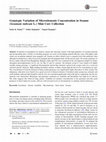
Evaluation of germplasm for mineral content and selecting varieties with high quantities of essen... more Evaluation of germplasm for mineral content and selecting varieties with high quantities of essential minerals and incorporating those varieties in breeding program can assist in developing mineral-efficient crops with higher yield which can accumulate minerals from marginal soil. Sesame an oldest oilseed crop is a popular food with medicinal value although its production is often focussed in marginal and sub-marginal lands. In the present study, 60 sesame genotypes of diverse origin collected from Bangladesh, Bulgaria, India and USA were examined in the acid-digested samples by atomic absorption spectrophotometer for Fe, Zn, Cu, Mn, Cr and Co contents. All elements except Cr were found to be highly variable among genotypes. A significant discrimination showed that elements content in the sesame seeds was a seed coat coloured specific character. High-yielding developed varieties of India contain high Zn but low Fe concentration in seed. The concentration of mineral elements in black-seeded genotypes was significantly higher than those in white seeded. The indigenous collections were found to be a good reservoir of mineral elements. Correlation study among trace elements and yield attributes indicated that though Fe and Zn were not correlated significantly with yield and its components, but the two elements were interrelated. Phenotypic and genotypic coefficient of variability and heritability were high for Fe and Zn. The study suggests that observed large genetic variability for element concentrations in the genotypes provides good prospects to breed improved sesame cultivars with elevated levels of micronutrients to mitigate mineral deficiency.

Sesame is an important oilseed crop, but application of molecular markers in sesame is yet to gai... more Sesame is an important oilseed crop, but application of molecular markers in sesame is yet to gain momentum. Microsatellite markers are used widely in development of different crops. Information on DNA sequence is a pre-requisite for generating micro satellite markers. Recent advancement of sequences and documentation in public data base has enabled scientists in mining data without any hassle. Further, analyzing the data by bioinformatics tools has made task of hunting for microsatellite markers easier and cost effective. In the present investigation, 371 microsatellites were identified for sesame (Sesamum indicum L.) through data mining and analyzing data by bioinformatics tools and the markers would be helpful for genetic mapping in sesame. Investigation on Functional Domain Markers (FDM) further enriched the study by delineating functional importance of the markers. Out of 371 primer pairs, only 11.25% primer pairs were polymorphic between the fifteen sesame genotypes examined. The number of alleles per SSR marker ranged from 2 to 6 per locus. A wide range of fragment sizes was observed from 100 to 376 bp. The number of alleles per polymorphic loci and the estimated genetic diversity were 2.75 and 0.44 respectively.
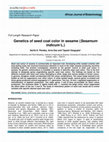
Seed coat colour of sesame is commercially an important trait. Developing white seeded varieties ... more Seed coat colour of sesame is commercially an important trait. Developing white seeded varieties with long lasting luster has received momentous attention in most of the major sesame producing countries including India. The present investigation centered on the genetic control of seed coat colour in sesame. No genetic nomenclature is available in sesame to describe seed coat colour. This is the first attempt to designate genes engendering specific seed coat colour. The findings are based on five different crosses with seed coat colour belonging to white, beige and various shades of brown colour. In general, tetragenic model corroborated with the colour combinations. The colour beige seemed to be fixable as well as suppressive over other colors. In white seeded seeds, several genes co-existed and those genes produced colored segregants in F 2 generation. Two loci, Gr and I, regulated suppression or intensification of pigment production. Two major genes V and B were accountable for basic colour production. The recessive allele 'b' tightly linked with 'r', resulted into beige colour which suppressed the effect either of the loci V and B. The study of inheritance pattern of seed coat would aid to evolve varieties with specific desired seed coat color.
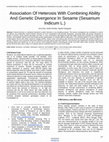
Parental diversity is considered desirable to exploit heterosis in any breeding program. The pres... more Parental diversity is considered desirable to exploit heterosis in any breeding program. The present investigation was undertaken to search out whether any relationship existed between heterosis of cross combinations with phenetic divergence, combining ability and genetic divergence of parents in sesame. Seven sesame genotypes and their 21 cross combinations developed through half diallel mating were assessed for morphological markers, microsatellite markers and seed storage protein polymorphism to estimate different parameters. The clustering patterns of parents differed for morphological, protein and simple sequence repeats (SSRs), though some concordance was observed between phenetic and genetic divergence of parents. Heterosis, both mid-parent heterosis% (MPH%) and better parent heterosis% (BPH%), was positively and significantly correlated with specific combining ability and hybrids per se, but no specific trend transpired between morphological, protein and SSR marker data. However, SSR based genetic diversity (GD) value of above 0.5 between parents, predicted heterotic crosses more reliably.
Bangladesh Journal of Botany, 2015
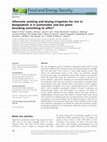
The crop management practice of alternate wetting and drying (AWD) is being promoted by IRRI and ... more The crop management practice of alternate wetting and drying (AWD) is being promoted by IRRI and the national research and extension program in Bangladesh and other parts of the world as a water-saving irrigation practice that reduces the environmental impact of dry season rice production through decreased water usage, and potentially increases yield. Evidence is growing that AWD will dramatically reduce the concentration of arsenic in harvested rice grains conferring a third major advantage over permanently flooded dry season rice production. AWD may also increase the concentration of essential dietary micronutrients in the grain. However, three crucial aspects of AWD irrigation require further investigation. First, why is yield generally altered in AWD? Second, is AWD sustainable economically (viability of farmers' livelihoods) and environmentally (aquifer water table heights) over long-term use? Third, are current cultivars optimized for this irrigation system? This paper describes a multidisciplinary research project that could be conceived which would answer these questions by combining advanced soil biogeochemistry with crop physiology, genomics, and systems biology. The description attempts to show how the breakthroughs in next generation sequencing could be exploited to better utilize local collections of germplasm and identify the molecular mechanisms underlying biological adaptation to the environment within the context of soil chemistry and plant physiology.
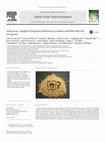
Science of The Total Environment, 2014
In a large scale survey of rice grains from markets (13 countries) and fields (6 countries), a to... more In a large scale survey of rice grains from markets (13 countries) and fields (6 countries), a total of 1578 rice grain samples were analysed for lead. From the market collected samples, only 0.6% of the samples exceeded the Chinese and EU limit of 0.2 μg g −1 lead in rice (when excluding samples collected from known contaminated/ mine impacted regions). When evaluating the rice grain samples against the Food and Drug Administration's (FDA) provisional total tolerable intake (PTTI) values for children and pregnant women, it was found that only people consuming large quantities of rice were at risk of exceeding the PTTI from rice alone. Furthermore, 6 field experiments were conducted to evaluate the proportion of the variation in lead concentration in rice grains due to genetics. A total of 4 of the 6 field experiments had significant differences between genotypes, but when the genotypes common across all six field sites were assessed, only 4% of the variation was explained by genotype, with 9.5% and 11% of the variation explained by the environment and genotype by environment interaction respectively. Further work is needed to identify the sources of lead contamination in rice, with detailed information obtained on the locations and environments where the rice is sampled, so that specific risk assessments can be performed.
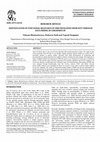
Jute (Corchorus spp.) is the second most important fibre producing plant in India. The study on j... more Jute (Corchorus spp.) is the second most important fibre producing plant in India. The study on jute at the molecular level till date is ver molecular markers in genetic studies. Recently with rapid advancement of sequencing and documentation in public data base has enabled scientists in hassle free data mining. Development of high throughput method for detection of SSRs has given a new dimension in their use as molecular markers. In the present study, 826 EST sequences of Corchorus capsularis and 30 EST sequences of Corchorus olitorius, downloaded from National Center for Biotechnolo were analyzed through bioinformatic tools like UniVec, trimest, CAP3, and MISA. Several microsatellite markers were identified for these two species of jute which would be further helpful for genetic mapping. The study of function functional property of microsatellite markers and predicted protein domains. The functional domains designed from SSR and should

Physiology and Molecular Biology of Plants, 2015
Sesame is an important ancient oilseed crop of high medicinal value. In the present study, 37 cha... more Sesame is an important ancient oilseed crop of high medicinal value. In the present study, 37 characters including both quantitative and qualitative traits of sixty genotypes were characterized following IPGRI morphological descriptors for sesame. Multivariate analysis was computed to distinguish the varieties into different groups. Though thirty six microsatellite markers including genomic and Est-SSR markers were initially selected, but, finally, the accessions were genotyped by eight polymorphic primers. Altogether, 27 alleles were detected among the 60 genotypes, with an average of 3.37 alleles per locus. The number of alleles ranged from 2 to 6 alleles. From data of microsatellite markers, dissimilarity coefficients between varieties were computed following Jaccard’s coefficient method. Principal co-ordinate analysis was used to represent the varieties in bi-directional space. Dendrogram was constructed using NJ method based on dissimilarity matrix. Cluster analysis based on morphological and molecular marker classified sesame genotypes into two major groups. Mantel test showed an insignificant correlation between phenotypic and molecular marker information. The genotypes belonging to the same geographical area did not always occupy the same cluster. The results confirmed that both genetic and phenotypic diversity in a combined way could efficiently evaluate the variation present in different sesame accessions in any breeding program.
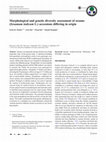
Sesame is an important ancient oilseed crop of high
medicinal value. In the present study, 37 cha... more Sesame is an important ancient oilseed crop of high
medicinal value. In the present study, 37 characters including
both quantitative and qualitative traits of sixty genotypes were
characterized following IPGRI morphological descriptors for
sesame. Multivariate analysis was computed to distinguish the
varieties into different groups. Though thirty six microsatellite
markers including genomic and Est-SSR markers were initially
selected, but, finally, the accessions were genotyped by
eight polymorphic primers. Altogether, 27 alleles were detected
among the 60 genotypes, with an average of 3.37 alleles per
locus. The number of alleles ranged from 2 to 6 alleles. From
data of microsatellite markers, dissimilarity coefficients between
varieties were computed following Jaccard’s coefficient
method. Principal co-ordinate analysis was used to represent
the varieties in bi-directional space. Dendrogram was constructed using NJ method based on dissimilarity matrix.
Cluster analysis based on morphological and molecular marker
classified sesame genotypes into two major groups. Mantel
test showed an insignificant correlation between phenotypic
and molecular marker information. The genotypes belonging
to the same geographical area did not always occupy the same
cluster. The results confirmed that both genetic and phenotypic
diversity in a combined way could efficiently evaluate the
variation present in different sesame accessions in any breeding program.
Variation in spermoderm features along with macromorphological characters of eighteen wild and cu... more Variation in spermoderm features along with macromorphological characters of eighteen wild and cultivated genotypes of Vigna were studied by scanning electron microscopy (SEM). On the basis of wax deposition, seed surface type is grouped in four groups. It is observed that though there were differences in seed coat colour and seed size in the wild progenitors of Vigna but the pattern of wax deposition on the seed coat is similar type.
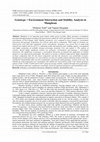
Mungbean is an important grain legume widely grown in India. Thirty genotypes of mungbean develop... more Mungbean is an important grain legume widely grown in India. Thirty genotypes of mungbean developed through mutation breeding from three parents namely B1, B105 and SML32 were evaluated on seven environments of West Bengal, India. Stability parameters were computed to know genotype x environment interaction and genotypic performance for yield per plant and its components. Wide range of variation was observed for seed yield and components across environments. Genotypes were grown best in sandy-loam textured soil coupled with low pH (5.7), indicating acidity and moderate water holding capacity, accompanied with higher proportion of available nitrogen percentage, moderate P 2 O 5 and organic C. The analysis of variance showed highly significant variance for genotypes, environments and genotype x environment interaction. The significance of genotype x environment interaction accentuated the implication of stability analysis in crop improvement programme. The analysis of variance exhibited comparatively higher magnitudes of linear components than the non linear components and thus the characters were predictable in nature. Identification of stable genotypes over environments was done by stability analysis following model of Eberhart and Russell. Sustainability index was also estimated for searching the stable genotypes. In most of the cases, the stability for yield components was concomitant with stability for seed yield per plant. Four mutant genotypes namely CUM1, CUM4, CUM10 and CUM13 registered average stability coupled with high mean performance for seed yield per plant and components consistently, based on regression parameters and sustainability index.
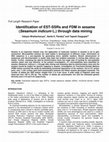
Sesame is an important oilseed crop, but application of molecular markers in sesame is yet to gai... more Sesame is an important oilseed crop, but application of molecular markers in sesame is yet to gain momentum. Microsatellite markers are used widely in development of different crops. Information on DNA sequence is a pre-requisite for generating micro satellite markers. Recent advancement of sequences and documentation in public data base has enabled scientists in mining data without any hassle. Further, analyzing the data by bioinformatics tools has made task of hunting for microsatellite markers easier and cost effective. In the present investigation, 371 microsatellites were identified for sesame (Sesamum indicum L.) through data mining and analyzing data by bioinformatics tools and the markers would be helpful for genetic mapping in sesame. Investigation on Functional Domain Markers (FDM) further enriched the study by delineating functional importance of the markers. Out of 371 primer pairs, only 11.25% primer pairs were polymorphic between the fifteen sesame genotypes examined. The number of alleles per SSR marker ranged from 2 to 6 per locus. A wide range of fragment sizes was observed from 100 to 376 bp. The number of alleles per polymorphic loci and the estimated genetic diversity were 2.75 and 0.44 respectively.
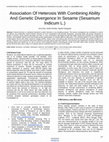
Parental diversity is considered desirable to exploit heterosis in any breeding program. The pres... more Parental diversity is considered desirable to exploit heterosis in any breeding program. The present investigation was undertaken to search out whether any relationship existed between heterosis of cross combinations with phenetic divergence, combining ability and genetic divergence of parents in sesame. Seven sesame genotypes and their 21 cross combinations developed through half diallel mating were assessed for morphological markers, microsatellite markers and seed storage protein polymorphism to estimate different parameters. The clustering patterns of parents differed for morphological, protein and simple sequence repeats (SSRs), though some concordance was observed between phenetic and genetic divergence of parents. Heterosis, both mid-parent heterosis% (MPH%) and better parent heterosis% (BPH%), was positively and significantly correlated with specific combining ability and hybrids per se, but no specific trend transpired between morphological, protein and SSR marker data. However, SSR based genetic diversity (GD) value of above 0.5 between parents, predicted heterotic crosses more reliably.

Arsenic (As) contamination of paddy soils threatens rice cultivation and the health of population... more Arsenic (As) contamination of paddy soils threatens rice cultivation and the health of populations relying on rice as a staple crop. In the present study, isotopic dilution techniques were used to determine the chemically labile (E value) and phytoavailable (L value) pools of As in a range of paddy soils from Bangladesh, India, and China and two arable soils from the UK varying in the degree and sources of As contamination. The E value accounted for 6.2-21.4% of the total As, suggesting that a large proportion of soil As is chemically nonlabile. L values measured with rice grown under anaerobic conditions were generally larger than those under aerobic conditions, indicating increased potentially phytoavailable pool of As in flooded soils. In an incubation study, As was mobilized into soil pore water mainly as arsenite under flooded conditions, with Bangladeshi soils contaminated by irrigation of groundwater showing a greater potential of As mobilization than other soils. Arsenic mobilization was best predicted by phosphate-extractable As in the soils.
Environmental Pollution, 2011
Spatial variations of arsenic concentrations in paddy soil and waters do not correlate to within-... more Spatial variations of arsenic concentrations in paddy soil and waters do not correlate to within-field variations of arsenic concentrations in rice grain.
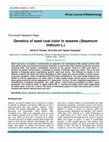
Seed coat colour of sesame is commercially an important trait. Developing white seeded varieties ... more Seed coat colour of sesame is commercially an important trait. Developing white seeded varieties with long lasting luster has received momentous attention in most of the major sesame producing countries including India. The present investigation centered on the genetic control of seed coat colour in sesame. No genetic nomenclature is available in sesame to describe seed coat colour. This is the first attempt to designate genes engendering specific seed coat colour. The findings are based on five different crosses with seed coat colour belonging to white, beige and various shades of brown colour. In general, tetragenic model corroborated with the colour combinations. The colour beige seemed to be fixable as well as suppressive over other colors. In white seeded seeds, several genes co-existed and those genes produced colored segregants in F 2 generation. Two loci, Gr and I, regulated suppression or intensification of pigment production. Two major genes V and B were accountable for basic colour production. The recessive allele 'b' tightly linked with 'r', resulted into beige colour which suppressed the effect either of the loci V and B. The study of inheritance pattern of seed coat would aid to evolve varieties with specific desired seed coat color.








Uploads
Papers by Tapash Dasgupta
medicinal value. In the present study, 37 characters including
both quantitative and qualitative traits of sixty genotypes were
characterized following IPGRI morphological descriptors for
sesame. Multivariate analysis was computed to distinguish the
varieties into different groups. Though thirty six microsatellite
markers including genomic and Est-SSR markers were initially
selected, but, finally, the accessions were genotyped by
eight polymorphic primers. Altogether, 27 alleles were detected
among the 60 genotypes, with an average of 3.37 alleles per
locus. The number of alleles ranged from 2 to 6 alleles. From
data of microsatellite markers, dissimilarity coefficients between
varieties were computed following Jaccard’s coefficient
method. Principal co-ordinate analysis was used to represent
the varieties in bi-directional space. Dendrogram was constructed using NJ method based on dissimilarity matrix.
Cluster analysis based on morphological and molecular marker
classified sesame genotypes into two major groups. Mantel
test showed an insignificant correlation between phenotypic
and molecular marker information. The genotypes belonging
to the same geographical area did not always occupy the same
cluster. The results confirmed that both genetic and phenotypic
diversity in a combined way could efficiently evaluate the
variation present in different sesame accessions in any breeding program.
medicinal value. In the present study, 37 characters including
both quantitative and qualitative traits of sixty genotypes were
characterized following IPGRI morphological descriptors for
sesame. Multivariate analysis was computed to distinguish the
varieties into different groups. Though thirty six microsatellite
markers including genomic and Est-SSR markers were initially
selected, but, finally, the accessions were genotyped by
eight polymorphic primers. Altogether, 27 alleles were detected
among the 60 genotypes, with an average of 3.37 alleles per
locus. The number of alleles ranged from 2 to 6 alleles. From
data of microsatellite markers, dissimilarity coefficients between
varieties were computed following Jaccard’s coefficient
method. Principal co-ordinate analysis was used to represent
the varieties in bi-directional space. Dendrogram was constructed using NJ method based on dissimilarity matrix.
Cluster analysis based on morphological and molecular marker
classified sesame genotypes into two major groups. Mantel
test showed an insignificant correlation between phenotypic
and molecular marker information. The genotypes belonging
to the same geographical area did not always occupy the same
cluster. The results confirmed that both genetic and phenotypic
diversity in a combined way could efficiently evaluate the
variation present in different sesame accessions in any breeding program.